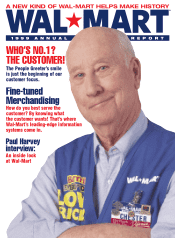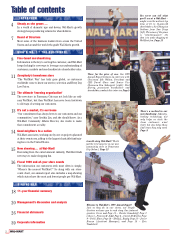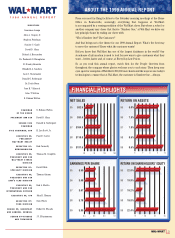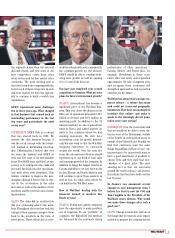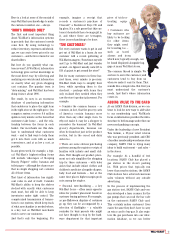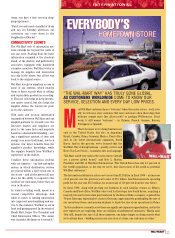Walmart 1999 Annual Report Download - page 10
Download and view the complete annual report
Please find page 10 of the 1999 Walmart annual report below. You can navigate through the pages in the report by either clicking on the pages listed below, or by using the keyword search tool below to find specific information within the annual report.
10
determine our members’
needs, and how best to meet
them.
Other new additions to
SAM’S Club’s departments that are
being tested include pharmacy, opti-
cal, one-hour photo and copy centers.
In each case, the new departments are
providing us with invaluable, real-
world information on how to improve
their operations and better serve our
members.
To add variety and spice to the lives of
our members while taking advantage
of merchandising opportunities, we
have been increasing our emphasis on
“road shows,” in which we bring
unique, high-end merchandise – such
as gourmet desserts, scuba equipment,
custom golf sets and many other kinds
of items – to a club for a limited period
of 10 to 12 days.
Each SAM’S Club facility hosts from two
to six road shows a month, and after a
while they begin to add up. Our road
show team planned and executed 20,000
road shows last year, partnering with
about 100 vendors – an impressive feat
of logistical execution in itself – and
exceeded its sales goal by several
million dollars.
And speaking of carefully targeted
merchandising, SAM’S Club has also
focused on regional buying – such as
stocking Motor City Cinnamon Bread™
in Detroit-area clubs or finding a
crawfish plate for our members in
Louisiana.
A CULTURE OF CHANGE
Wal-Mart is not afraid of change. Our
computerized merchandising aids
were but a gleam in some program-
mer’s eye only a few years ago, but
Wal-Mart committed itself to taking as
much advantage of new technology as
possible. In the process, we learned
that information can be leveraged into
new ideas for serving our customers.
And at the same time, each new idea is
a source of fresh information.
For example: At about 40,000 square feet,
one of Wal-Mart’s new Neighborhood
Markets is less than one-fourth the size of
a Supercenter, and stocks only 20,000 to
23,000 different items in a store, com-
pared to more than 100,000 items at a
Supercenter. The Neighborhood Market
combines grocery and dry-goods depart-
ments with such convenience-oriented
features as a drive-through pharmacy.
The Supercenter is a key engine of our
current growth. In the past year, we
celebrated both the 10th anniversary
of the Supercenter and the 500th
Supercenter to open. At first, it may
seem strange to open much smaller
stores with stock similar to both
Discount Store and grocery merchan-
dise, but the Neighborhood Market does
not compete with Supercenters – it
complements them. The Neighborhood
Market aims to fill a niche we may not
be serving today.
At the same time, because the first
Neighborhood Markets are test stores,
we can use them as merchandising lab-
oratories. Our newest ideas in product
placement, store design and retailtain-
ment (please see accompanying story)
can be tested while, at the same time,
offering a shopping experience aimed
directly at our customers’ needs.
“Again and again our customers tell us
they expect more convenience these
days,” said Henry Jordan, Director of
Operations for the Neighborhood
Markets. “A lot of times, customers go
to Supercenters and it is convenient,
because if you need a wide variety of

